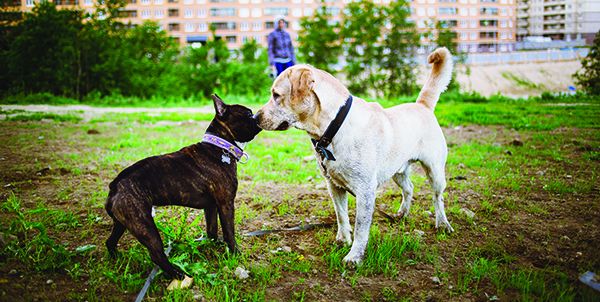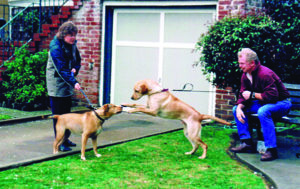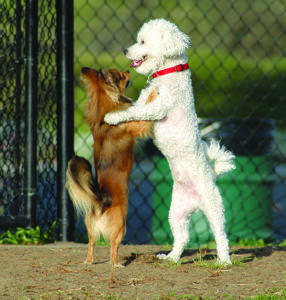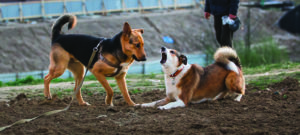
Given that our canine companions are a social species, you might think introducing two dogs would be a simple matter of turning them loose together and letting them take care of the rest. If only it were so?! If you have ever been present when a canine meet-and-greet suddenly exploded into a whirlwind of growling, snarling, lunging dogs, you are probably aware there is more to it than just “Go play!”
Certainly, there are some dogs who are so socially adept that they can easily meet and greet new canine playmates with ease, but a significant percentage of our dogs can benefit from some assistance to effect successful introductions.
ORCHESTRATE GOOD GREETINGS
So then, how do you successfully introduce your dog to new canine friends?
For starters, you’ll want one handler per dog. One skilled handler, that is. Someone who panics and intervenes unnecessarily can botch the whole job by adding stress to dogs who are still sorting out relationships.
Barring skilled handlers, at least find handlers who are good at following instructions and don’t succumb easily to hysterical behavior. If you can’t find those, you’re better off with fewer handlers, although you should have at least one other person present, if for no other reason than to call 9-1-1 if the situation gets out of hand.
You probably already have a pretty good sense of your own dog’s canine social skills, and hopefully the other dog’s person does as well. Do they play well with others at the dog park? During playtime at good manners class? With their own canine family members? How do they act with doggie visitors to their homes? During chance encounters with other canines on the streets?
If you’re not reasonably confident that introductions will go smoothly, you might do well to engage the services of a qualified behavior professional to help your dog meet new friends, at least the first time or two. She will be able to help you read and understand the dogs’ body language and optimize the potential for success.
NEUTRAL LOCATION
Your best bet is to find a neutral, safely fenced, outdoor area in which to begin the relationship. Indoors is too cramped and confining – a less-than confident dog can easily feel trapped as the other dog backs her into a corner. Wide open spaces tend to work better.
A neutral spot (neither dog’s home) is ideal, so that neither dog feels defensive of his yard or people. If you can’t find neutral, your own yard might work, as long as your dog doesn’t have a history of reactive behavior in that space.
But maybe you don’t have a safely fenced yard, or your dog does have a history of reactive behavior in your yard. A large, uncluttered garage or warehouse space might work. Perhaps a friend, neighbor, or co-worker has a fenced yard you can borrow for a bit.

It seems intuitive that it would be safer to hold your dog’s leash during greetings, so you can separate the dogs easily if it doesn’t go well. However, there are a number of reasons why this practice is fraught with hazards (and why I don’t allow this at Peaceable Paws, my training center):
* Leashes restrict a dog’s ability to behave naturally during greeting. If a dog is uncertain about meeting another, she might normally move away. But if she is restrained by a leash and knows she can’t move away, she’s more likely to behave defensively aggressive. In a normal, leash-free greeting, dogs might circle and sniff, retreat, and then approach again. Leashes get in the way of all that – and also tangle quickly if one dog suddenly tried to initiate play – and the other dog might panic at the sudden proximity she’s forced into by the tangle. Ack!
* A tight leash adds stress, and stress causes aggression. I have seen more than one greeting that appeared to be going well until one or both humans tightened their leashes and – boom! – triggered an aggressive response from their dogs.
* Routine on-leash greetings can create an expectation for your dog that she will be able to greet every dog she sees. This may result in frustration reactivity on those occasions when she isn’t immediately allowed to meet and greet. Often, these dogs get along beautifully with others off-leash at the dog park, but become extremely aroused – even at a considerable distance – when they are on leash and see another dog that they can’t run up to greet. I’d estimate that about one-third of the dogs who come to my Reactive Rover workshops exhibit this frustration reactivity. These are almost invariably dogs who frequently have been allowed to do on-leash greetings with other dogs.
START WELL APART
With the space secured, the process I use and recommend to clients is to start with dogs on leashes on opposite sides of the enclosed space. Keep the leashes loose, if possible. Watch the dogs’ behavior. They should seem interested in each other, alert without excessive arousal. Ideally, you’ll see tails wagging at half-mast, soft, wriggling body postures, play bows, ears back, squinty eyes, and no direct, hard eye contact. These are clear expressions of non-aggressive social invitation.
Warning signs include stiffness in the body, standing tall, ears pricked hard forward, growling, hard direct eye-contact, stiffly-raised fast-wagging tails, perhaps even lunging on the leash, and aggressive barking.
If you see appropriate social behavior, proceed with the approach until the dogs are about 10 feet apart. If they continue to show unambiguous signs of friendliness, drop the leashes and let them meet.
Yes, I said drop the leashes. I prefer not to let dogs meet and greet with handlers holding the leashes. Leashes tend to interfere with the dogs’ ability to greet normally, and can actually induce dogs to give false body language signals. For example, a tight leash can stiffen and raise a dog’s front end, causing her to look more tense and offensive than she means to be, which in turn can cause the other dog to react offensively. A defensive dog who wants to retreat may feel trapped because of the leash and act aggressively because she can’t move away.
Leave leashes on the dogs initially, dragging freely on the ground, so you can grab them and separate dogs easily if necessary.
Keep monitoring the greeting. You are likely to see some normal jockeying for position and some tension, as they sniff and circle and then erupt into play.
As soon as you can tell that they’re getting along, remove their leashes and let them play unencumbered.

When you select your dog’s playmates, it’s important to consider what sort of dogs might make good personality matches – and which might be a disaster.
If your dog likes to assert herself, you’re wise to choose a play pal who’s happy to maintain a lower profile. If your dog is a shrinking violet, she’ll be happiest with a new companion who doesn’t come on like a freight train or bully her playmates mercilessly. If you have one of those canine gems who gets along with everyone, then you have more playmate options. If you want your gem to be able to be “queen of the hill,” then look for soft, appeasing-type dog friends.
If you don’t care where your easygoing dog ends up in the new relationship, then you have the entire canine personality continuum to choose from. Of course, you should avoid dog-aggressive dogs who might give yours a bad experience that could color her future canine relationships.
IF IT STARTS TO GO BAD
Watch that the play doesn’t escalate into excessive arousal (which can lead to aggression) but remember that it’s normal and acceptable for dogs to growl and bite each other in play. As long as both dogs seem to be enjoying the action, it’s a good thing.
If arousal levels escalate, especially if one dog starts to appear concerned about the arousal level, cheerfully call the dogs away from each other for a calming time-out. Take a break until they are both quite calm, then release them to play again.
If you see warning signs as you approach with the dogs on leash, you’ll need to go more slowly. If you observe behavior that looks like outright reactivity or aggression, you’ll need to make a judgment call about whether the intensity of the behavior is such that you need to stop and seek professional assistance, or mild enough that you can proceed with caution.
If you do decide to proceed, interrupt prolonged hard eye contact by having each handler divert her dog’s attention with bits of tasty treats. Continue to work with the dogs in each other’s presence, watching for signs of decreasing arousal.
Walk around the available space with the dogs at maximum distance, gradually bringing them closer together until they are walking parallel to each other. You might take them for a walk around the block, maintaining safe parallel distance. It’s important that you stay calm and relaxed during this process. If you jerk or tighten the leash, badger one or both of the dogs with a constant stream of warnings (“No … no! Be nice! Don’t even think about it! No growling!” etc.), or yell at them, you’ll add stress to the situation and make it harder for them to relax.
When you see signs that the dogs have relaxed with each other, spend a few (or several) more minutes sitting quietly near each other, far enough apart the dogs aren’t trying to interact. When they continue to appear reasonably relaxed, you may choose to end the introduction for the time being. Do several more on-leash sessions over a period of several days before dropping leashes. Alternatively, you may decide to proceed with dropped-leash greetings. This is where your experience and instincts come into play. It’s generally better to err on the side of caution and do several more on-leash sessions to make sure the dogs are comfortable with each other.
Again, if you’re not confident in your judgment about canine body language, you may choose to enlist the help of a professional at this point.
NO SUCCESS?

If tensions between the dogs escalate or maintain at the same level of intensity despite your on-leash work over several sessions, the wise choice may be to look for a different playmate. If, however, you are trying to introduce your dog to a dog that you really hope will become a compatible friend – perhaps because the dog belongs to a good friend, dating partner, relative, or co-worker (in the case of dogs who come to work), or perhaps even one you’re considering adopting – this would be a good time to do ongoing work with a behavior professional to try to make the relationship work, knowing that management may be a large part of the relationship for the foreseeable future.
Be careful if you see no interaction between the two dogs you’re trying to introduce. What appears to be calm acceptance may in fact be avoidance behavior – neither dog is comfortable with the other, and they choose to deal with it by not dealing with it. The problem with this is that sooner or later the dogs will interact if they’re in each other’s presence frequently, and the discomfort may well develop into aggression. I really want to see some interaction between dogs in order to be comfortable that they will play well together.
ALL’S WELL THAT ENDS WELL
I’ve had clients ask me, “If dogs are a social species, why don’t they all just get along with each other?” My response is, “We humans are a social species, and we certainly don’t all get along!”
Fortunately, the majority of our dogs can have canine playmates, although we sometimes need to help them be friends. Even dogs who don’t normally do well with other dogs can, with careful introductions, learn to accept new canine friends and family members. And if you have a dog who can’t, accept him for who he is. He’ll probably be much happier if you stop trying to get him to like other dogs.
Here are some additional things you can do to increase your potential for successful introductions:
✔ Exercise both dogs before initiating introductions. Happy, tired dogs are more likely to interact well than those who are bursting with energy.
✔ Be sure to remove toys and other high-value chew objects from the introduction area to minimize potential for guarding incidents.
✔ Use extra caution when introducing a puppy to an adult dog to avoid physical injury or psychological trauma to your pup. While many adult dogs recognize the importance of being gentle with baby dogs, some do not. Some will play too roughly and some will be actively aggressive. A bad experience with an overly exuberant playmate or an aggressive dog can have a significant negative influence on a pup’s future social behavior.
✔ Use extra caution when introducing a new dog to a senior dog, especially if the new dog is a high energy adolescent or a puppy. Protect the senior dog from being physically damaged – bumped, bruised, body-slammed, or knocked over by a rambunctious pup. Keep the youngster on leash or use baby gates to keep them separated until the pup learns to modulate his behavior around the fragile, perhaps grumpy senior. Geriatric dogs shouldn’t have to defend themselves from overwhelming attentions from fractious youngsters. Unless this is a new dog you are introducing to your own family, you are better off selecting more appropriate playmates.
✔ Consider size. Noted trainer and behavior professional Jean Donaldson recommends no more than a 25-pound difference in size between dogs in a household or play relationship. More than that, she warns, and you risk injury to the smaller dog if the larger one is too energetic or aroused.
✔ When working with particularly large or strong dogs, or dogs who have been involved in any past incidents involving aggression, it’s a good idea to have some tools within easy reach, in case you need to interrupt an aggressive interaction. These tools might include:
• Loud noises, such as a loud yell, banging two metal pans together, or a marine air horn.
• Aversive sprays, such as lemon juice in a spray bottle, Halt! dog repellent spray, or a blast from a hose or a fire extinguisher.
• A separating board. Keep your hands out of the danger zone by using a physical object to break up a fight. (You have to plan for this in advance.) Attach two handles to a sheet of plywood. When a fight happens, lower the board between the sparring dogs. The board will push them apart and provide a physical barrier between them to prevent a new grab.
• Blankets. Tossed over fighters, one over each, blankets muffle outside stimuli, reducing arousal. This also allows humans to physically separate the combatants by picking up the pups-in-a-blanket and pulling them apart with less risk of a serious bite; the blanket will cushion the effect of teeth on skin if the dog does whirl and bite.
• A “parting stick” (also known as a “break stick”). This tool can be inserted into the mouth of a dog who won’t unclench his jaws and let go of another dog. Often carved from a wood hammer handle, the stick is tapered to a rounded point at one end. When dogs are locked in combat, the parting stick is forced between a dog’s teeth and turned sideways to pry open the jaws. Caution: Parting sticks can break teeth, and a dog whose jaws have just been “parted” may turn on the person doing the parting.




